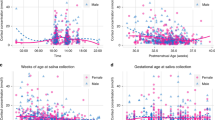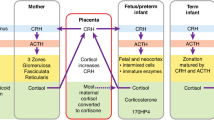Abstract
Background
Extremely preterm (EPT) birth has been related to dysregulation of stress responses and behavioral/learning problems at school age. Early adverse experiences can blunt HPA axis reactivity. We hypothesized that an attenuated cortisol awakening response would be associated with developmental and behavioral problems at school age in EPT children.
Methods
This secondary analysis of a sub-cohort of the SUPPORT study included children born between 24 and 27 weeks, evaluated at 6–7 years with a neurodevelopmental battery and cortisol measures. Differences were tested between EPT and a term-born group. Relationships of cortisol awakening response to test scores were analyzed.
Results
Cortisol was measured in 110 EPT and 29 term-born 6–7 year olds. Unadjusted WISC-IV and NEPSY-II scores were significantly worse among EPT children only. Conners Parent Rating Scale behavior scores were significantly worse among EPT children. After adjusting for covariates, blunted cortisol awakening responses were found to be associated with poorer scores on memory tests and greater problems with inattention for the EPT group (p < 0.05) only.
Conclusions
Among children born EPT, we identified an association of blunted cortisol awakening response with memory and inattention problems. This may have implications related to stress reactivity and its relationship to learning problems in children born EPT.
ClinicalTrials.gov ID
Extended Follow-up at School Age for the SUPPORT Neuroimaging and Neurodevelopmental Outcomes (NEURO) Cohort: NCT00233324.
Impact
-
In children born EPT, stress reactivity may have a relationship to learning problems.
-
Cortisol awakening response should be a component for follow-up in EPT born children.
-
Components of executive function, such as memory and attention, are related to stress reactivity.
Similar content being viewed by others
Log in or create a free account to read this content
Gain free access to this article, as well as selected content from this journal and more on nature.com
or
Data availability
Data reported in this paper may be requested through a data use agreement. Further details are available at https://neonatal.rti.org/index.cfm?fuseaction=DataRequest.Home.
References
Newnham, C. A., Inder, T. E. & Milgrom, J. Measuring preterm cumulative stressors within the NICU: The Neonatal Infant Stressor Scale. Early Hum. Dev. 85, 549–555 (2009).
Pourkaviani, S. et al. Clinical validation of the Neonatal Infant Stressor Scale with preterm infant salivary cortisol. Pediatr. Res. 87, 1237–1243 (2020).
Provenzi, L. et al. Pain-related stress in the Neonatal Intensive Care Unit and salivary cortisol reactivity to socio-emotional stress in 3-month-old very preterm infants. Psychoneuroendocrinology 72, 161–165 (2016).
McLean, M. A. et al. Sensory processing and cortisol at age 4 years: procedural pain-related stress in children born very preterm. Dev. Psychobiol. 63, 915–930 (2021).
Brummelte, S. et al. Cortisol levels in relation to maternal interaction and child internalizing behavior in preterm and full‐term children at 18 months corrected age. Dev. Psychobiol. 53, 184–195 (2011).
Kaseva, N. et al. Adrenalin, noradrenalin and heart rate responses to psychosocial stress in young adults born preterm at very low birthweight. Clin. Endocrinol. 81, 231–237 (2014).
Grunau, R. E. Neonatal pain in very preterm infants: long-term effects on brain, neurodevelopment and pain reactivity. Rambam Maimonides Med. J. 4, 1–13 (2013).
Valeri, B. O., Holsti, L. & Linhares, M. B. Neonatal pain and developmental outcomes in children born preterm: a systematic review. Clin. J. Pain. 31, 355–362 (2015).
Leneman, K. B., Donzella, B., Desjardins, C. D., Miller, B. S. & Gunnar, M. R. The slope of cortisol from awakening to 30 min post-wake in post-institutionalized children and early adolescents. Psychoneuroendocrinology 96, 93–99 (2018).
Watterberg, K. L. et al. Adrenal function links to early postnatal growth and blood pressure at age six in children born extremely preterm. Pediatr. Res. 86, 339–347 (2019).
Wagner, S. L. et al. Higher cortisol is associated with poorer executive functioning in preschool children: The role of parenting stress, parent coping and quality of daycare. Child Neuropsychol. 22, 853–869 (2016).
BussKara, A. T. & Lowery N. in Encyclopedia of Infant and Early Childhood Development (Second Edition) (Haith, M. M. & Benson, J. B.) 183–193 (Academic, 2020).
Cassiano, R. G. M., Gaspardo, C. M. & Linhares, M. B. M. Temperament moderated by neonatal factors predicted behavioral problems in childhood: a prospective longitudinal study. Early Hum. Dev. 135, 37–43 (2019).
Hutchinson, E. A., De Luca, C. R., Doyle, L. W., Roberts, G. & Anderson, P. J. School-age outcomes of extremely preterm or extremely low birth weight children. Pediatrics 131, e1053–e1061 (2013).
Rogers, E. E. & Hintz, S. R. Early neurodevelopmental outcomes of extremely preterm infants. Semin. Perinatol. 40, 497–509 (2016).
Grunau, R. E. et al. Altered basal cortisol levels at 3, 6, 8 and 18 months in infants born at extremely low gestational age. J. Pediatr. 150, 151–156 (2007).
Brummelte, S. et al. Cortisol levels in relation to maternal interaction and child internalizing behavior in preterm and full-term children at 18 months corrected age. Dev. Psychobiol. 53, 184–195 (2011).
Grunau, R. E. et al. Neonatal pain-related stress and NFKBIA genotype are associated with altered cortisol levels in preterm boys at school age. PLoS ONE 8, e73926 (2013).
Chau, C. M. Y. et al. The Val66Met brain-derived neurotrophic factor gene variant interacts with early pain exposure to predict cortisol dysregulation in 7-year-old children born very preterm: implications for cognition. Neuroscience 342, 188–199 (2017).
Brummelte, S. et al. Cortisol levels in former preterm children at school age are predicted by neonatal procedural pain-related stress. Psychoneuroendocrinology 51, 151–163 (2015).
Hintz, S. R. et al. Preterm neuroimaging and school-age cognitive outcomes. Pediatrics 142, e20174058 (2018).
Wechsler, D. Wechsler Intelligence Scale for Children: Fourth Edition (WISC-IV) (PsychCorp 2003).
Korkman, M., Kirk, U. & Kemp, S. NEPSY-II: Clinical and Interpretation Manual (Pearson Corp, 2007).
Conners, C. K. Conners’ Rating Scales–Revised: Technical Manual (Multi-Health Systems 1997).
Odd, D., Evans, D. & Emond, A. M. Prediction of school outcome after preterm birth: a cohort study. Arch. Dis. Child. 104, 348–353 (2019).
Linsell, L. et al. Trajectories of behavior, attention, social and emotional problems from childhood to early adulthood following extremely preterm birth: a prospective cohort study. Eur. Child Adolesc. Psychiatry 28, 531–542 (2019).
Schappin, R., Wijnroks, L., Uniken Venema, M. & Jongmans, M. Exploring predictors of change in behavioral problems over a 1- year period in preterm born preschoolers. Infant Behav. Dev. 50, 98–106 (2018).
Dotinga, B. M. et al. Longitudinal growth and emotional and behavioral problems at age 7 in moderate and late preterms. PLoS ONE 14, e0211427 (2019).
Brumbaugh, J. E., Hodel, A. S. & Thomas, K. M. The impact of late preterm birth on executive function at preschool age. Am. J. Perinatol. 31, 305–314 (2014).
Raffington, L. et al. Blunted cortisol stress reactivity in low–income children relates to lower memory function. Psychoneuroendocrinology 90, 110–121 (2018).
Acknowledgements
Participating NRN sites collected data and transmitted it to RTI International, the data coordinating center (DCC) for the network, which stored, managed, and analyzed the data for this study. On behalf of the NRN, RTI International had full access to all of the data in the study, and with the NRN Center Principal Investigators, takes responsibility for the integrity of the data and accuracy of the data analysis. We are indebted to our medical and nursing colleagues and the infants and their parents who agreed to take part in this study.
Funding
The National Institutes of Health, the Eunice Kennedy Shriver National Institute of Child Health and Human Development (NICHD), and the National Heart, Lung, and Blood Institute (NHLBI) provided grant support for the Neonatal Research Network’s Extended Follow-up at School Age for the SUPPORT Neuroimaging and Neurodevelopmental Outcomes (NEURO) Cohort through cooperative agreements. While NICHD staff had input into the study design, conduct, analysis, and manuscript drafting, the comments and views of the authors do not necessarily represent the views of NICHD, the National Institutes of Health, the Department of Health and Human Services, or the U.S. Government.
Author information
Authors and Affiliations
Consortia
Contributions
J.L. and K.L.W.: conception and design, acquisition, analysis and interpretation of data, drafting the article, and final approval of the version to be published. J.F.F.: acquisition of data, critical revision of the article for important intellectual content, and final approval of the version to be published. A.D.: conception and design, drafting the article and final approval of the version to be published. B.D. and A.G.D.: analysis and interpretation of the data, revising it critically for important intellectual content, and final approval of the version to be published. C.M.B.: analysis and interpretation of the data, revising it critically for important intellectual content, final approval of the version to be published. K.E.G.: substantial contributions to conception, design, acquisition of data, drafting the article revising it critically for important intellectual content, and final approval of the version to be published. B.R.V.: acquisition and interpretation of data, critical revision of the article for important intellectual content, and final approval of the version to be published. S.R.H.: conception and acquisition of the data, revising it critically for important intellectual content, and final approval of the version to be published.
Corresponding author
Ethics declarations
Competing interests
A.G.D. is founder and chief scientific and strategy advisor at Salimetrics LLC and Salivabio LLC. The nature of those relationships is managed by the policies of the committees on conflict of interest at the Johns Hopkins University School of Medicine and the University of California at Irvine.
Ethics approval and consent to participate
Patients were consented at each institution per each institution’s IRB requirements.
Additional information
Publisher’s note Springer Nature remains neutral with regard to jurisdictional claims in published maps and institutional affiliations.
Rights and permissions
About this article
Cite this article
Lowe, J., Fuller, J.F., Dempsey, A.G. et al. Cortisol awakening response and developmental outcomes at 6–7 years in children born extremely preterm. Pediatr Res 93, 689–695 (2023). https://doi.org/10.1038/s41390-022-02113-9
Received:
Revised:
Accepted:
Published:
Issue date:
DOI: https://doi.org/10.1038/s41390-022-02113-9



